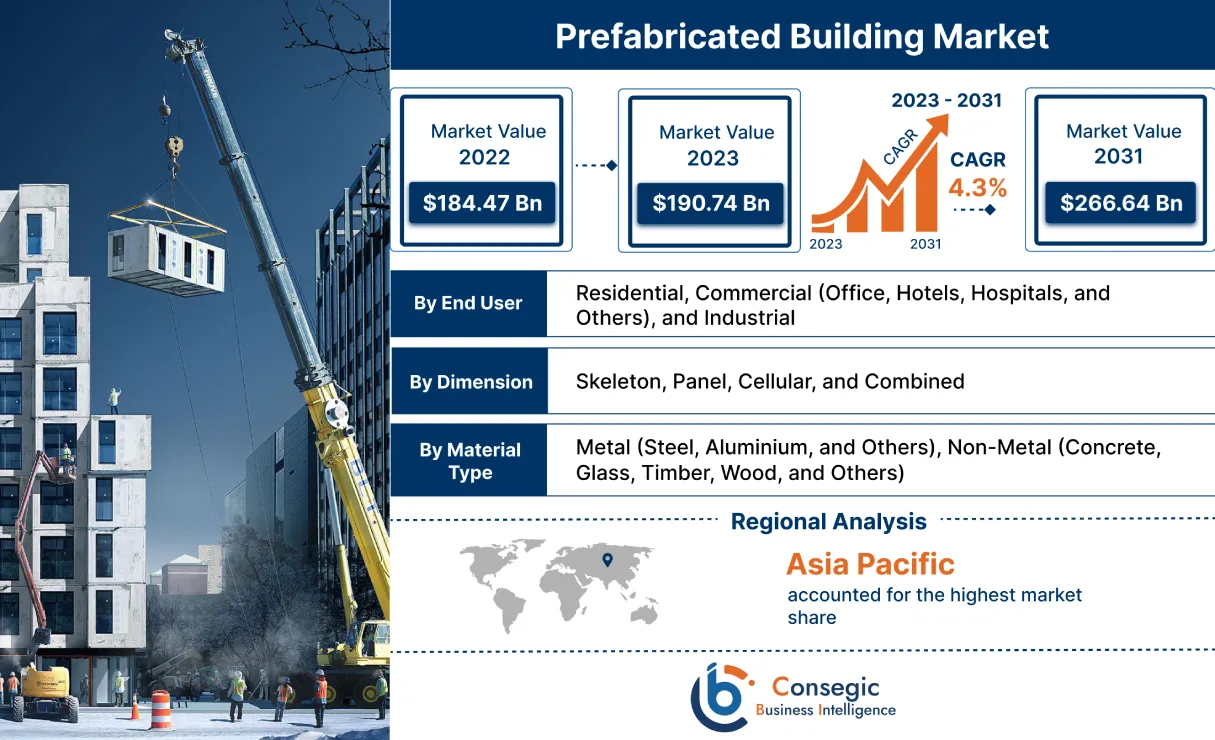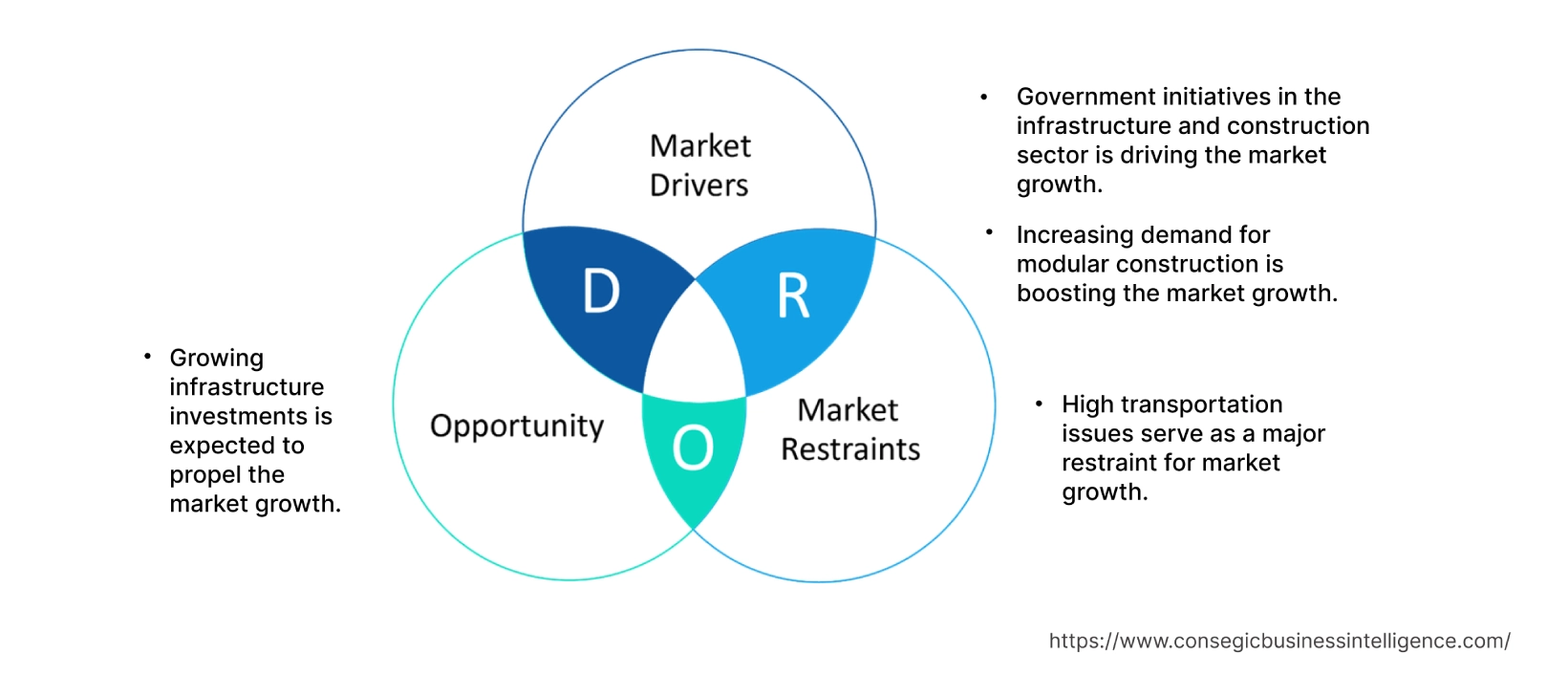- Summary
- Table Of Content
- Methodology
Prefabricated Building Market Size :
Consegic Business Intelligence analyzes that the prefabricated building market size is growing with a CAGR of 4.3% during the forecast period (2023-2031), and the market is projected to be valued at USD 266.64 Billion by 2031 and USD 190.74 Billion in 2023 from USD 184.47 Billion in 2022.
Prefabricated Building Market Scope & Overview:
A prefabricated building is manufactured and constructed using prefabrication. It consists of factory-made components or units that are transported and assembled on-site to form the complete building. The buildings with different components such as walls, roofs, and floors are manufactured in a factory or a manufacturing plant. The components are fully or partially assembled in a factory and then transferred to a site. This method of building is preferred due to its fast turnaround, cost efficiency, and reusability. As per the analysis, certain common applications of these buildings include office spaces, construction facilities, medical camps, apartment blocks, and others. It is more efficient than conventional on-site construction as manufacturing through a production line is much more controlled. These buildings are widely demanded due to the growing need for housing and commercial spaces, coupled with standardization of construction and building codes.
Prefabricated Building Market Insights :
Key Drivers :
Government initiatives in the infrastructure and construction sector is driving the market growth
Prefabricated construction is a method of building that involves manufacturing components of a building off-site in a factory, then transporting and assembling them on-site. The government initiatives and investments in the infrastructure and construction sector, especially in emerging nations, are boosting the f prefabricated building market trends. Governments of different nations have been laying out different schemes and initiatives for infrastructure projects globally. For instance, according to an article by Make in India in 2021, under Pradhan Mantri Awas Yojana, an initiative by the Government of India, houses will be constructed with eco-friendly technology and families will get central assistance to enhance their existing houses or construct new houses. Based on the analysis, the Government has also proposed a new scheme which is Housing for All, under the same initiative for the urban areas. Furthermore, according to a report by India Brand Equity Foundation, in 2022, the Government of India has allowed FDI of up to 100% for townships and settlements development projects. Hence, increasing government initiatives and schemes for better infrastructure and improved construction sector help to boost the trends for the market.
Increasing demand for modular construction is boosting the market expansion
Prefabricated building materials are largely incorporated into modular construction projects in educational institutes, residential spaces, airports, and others. Moreover, increasing disposable income, and growing private sector investment in construction is boosting the utilization of modular constructions. Also, less construction time involved in modular constructions through fabricated materials and the cost efficiency of the products has been driving major requirements for modular construction activities. Furthermore, prefabricated materials are widely used in ventilated thermal panels, bathroom pods, kitchenettes, and others owing to the materials being environmentally friendly, flexible, and causing minor site disruption. Also, certain features of the prefabricated materials such as viability for different designs, construction of distinctive homes, and others are acting as catalysts for increasing modular constructions, thus boosting the prefabricated building market. Hence, due to the aforementioned factors, the high requirement for modular construction globally is increasing the prefabricated building market growth and trends.
Key Restraints :
High transportation issues serve as a major restraint for market expansion
The transportation and logistics costs involved in the movement of the prefabricated materials are high, and thus it proves to be a major restraint for market trends. The prefabricated materials are mostly made in rural areas due to the availability of cheap labor. Furthermore, based on the analysis, transporting volumes of prefabricated materials is difficult and it requires special heavy vehicles and heavy-duty cranes. Thus, factors such as expensive transportation, risk of damaged delivery of goods, untimely delivery, and others serve as major restraints for the prefabricated building market demand. For this reason, high transportation issues is acting as a restraint for hampering the market trends.
Future Opportunities :
Growing infrastructure investments are expected to propel the market growth
The increasing infrastructure investments, especially in commercial real estate, are creating lucrative prefabricated building market opportunities and trends in the forecast period. Also, as per the analysis, rising concerns about construction waste and the promotion of green buildings is boosting the market growth. Furthermore, the wide usage of prefabricated materials in commercial buildings coupled with the increasing commercial sector globally is driving the requirements and opportunities of the market. For instance, according to a recent report by the Indian Brand Equity Foundation in 2023, the Indian real estate market is expected to increase to around USD 1 trillion in 2030. Hence, due to increasing infrastructure investments and growing commercial industry, the market is expected to flourish significantly in the forecast period.
Prefabricated Building Market Report Insights :
| Report Attributes | Report Details |
| Study Timeline | 2017-2031 |
| Market Size in 2031 | USD 266.64 Billion |
| CAGR (2023-2031) | 4.3% |
| By Material Type | Metal (Steel, Aluminium, and Others), Non-Metal (Concrete, Glass, Timber, Wood, and Others) |
| By Dimension | Skeleton, Panel, Cellular, and Combined |
| By End User | Residential, Commercial (Office, Hotels, Hospitals, and Others), and Industrial |
| By Region | North America, Europe, Asia-Pacific, Latin America, and Middle East & Africa |
| Key Players | EPACK Prefab, Arthroto, CertainTeed, Mighty Buildings , Everest Industries Limited, Satec Envir Engineering (India) Private Limited, Balarka Fabricon Private Limited, Astron Buildings, Champion Home Builders, and Algeco Scotsman |
Prefabricated Building Market Segmental Analysis :
By Material Type :
The material type segment is categorized into metal and non-metal. In 2022, the metal segment accounted for the highest market share in the prefabricated building market. The metal segment is further bifurcated into steel, aluminium, and others. Steel is the most widely used material owing to its high strength and durability. Steelwork is widely required as it forms the skeleton frame of a building. Steel framing is also associated with on-site design and helps in holding the structure of the building. Hence, due to the aforementioned factors, the metal segment is witnessing significant growth in the prefabricated building market.
Moreover, the non-metal segment is expected to grow at the fastest CAGR over the forecast period in the prefabricated building market. The non-metal segment is further bifurcated into concrete, glass, timber, wood, and others. Concrete is in high requirement as it provides thermal insulation and improves the energy efficiency of the building. Based on the analysis, wood material is also incorporated largely in applications such as floor structures, engineered joists, and others as it offers increased strength while remaining lightweight. Also, the recyclability feature of the material is further boosting the growth of the wood material. Hence, due to the aforementioned features, the non-metal segment is expected to flourish significantly in the forecast years.
By Dimension :
The dimension segment is categorized into skeleton, panel, cellular, and combined. In 2022, the panel segment accounted for the highest market of 33.27% in the prefabricated building market. Owing to certain features of the panel segment such as short production time, adaptable designs, easy services of transportation and installation, and easy re-location, among others, propel the requirement for panel systems. Furthermore, as per the analysis, owing to high thermal efficiency and cost savings on labor, the segment is experiencing positive growth. Hence, due to the aforementioned factors, the panel dimension is witnessing significant growth in the prefabricated building market.
Moreover, the skeleton segment is expected to grow at the fastest CAGR over the forecast period in the prefabricated building market. This dimension is largely incorporated for low-risk structures having minimal partitions such as car parking and commercial buildings. Moreover, based on the analysis, growing urbanization coupled with increasing commercial constructions globally is leading to a larger requirement for skeleton systems. For instance, according to a report by Invest India in 2022, between April 2000 and December 2021, Foreign Direct Investment (FDI) in construction development totaled around USD 26.17 billion. Hence, due to the increasing commercial industry globally, the segment is increasing positively in the prefabricated building market.
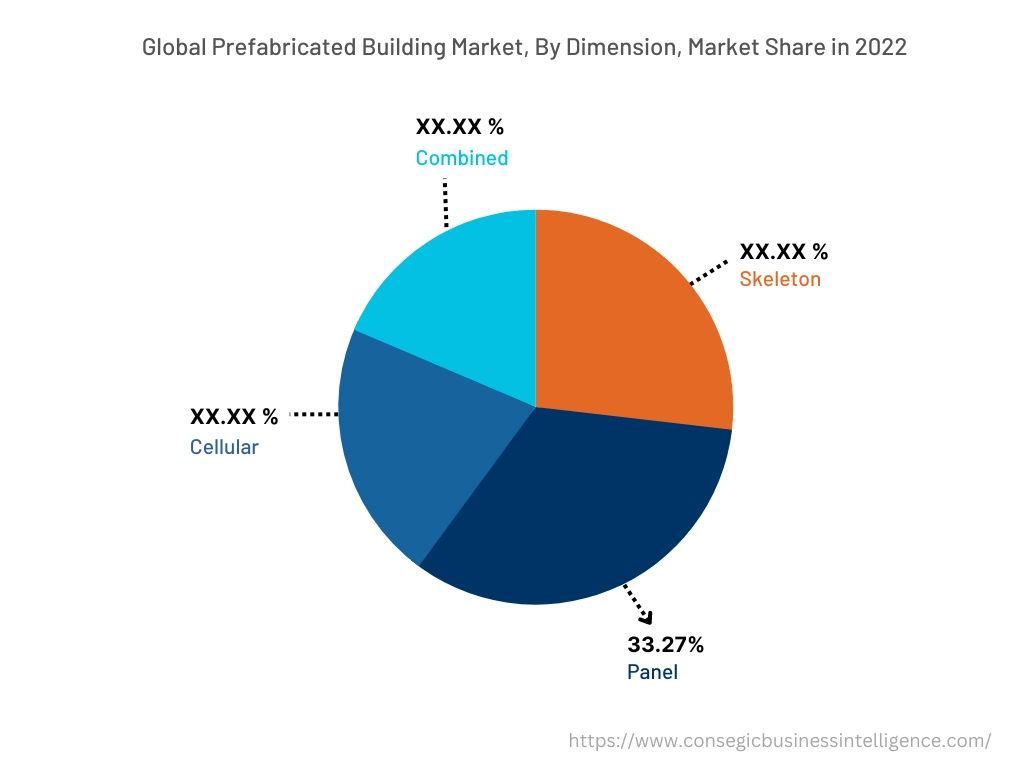
By End-User :
The end user segment is categorized into residential, commercial, and industrial. In 2022, the commercial segment accounted for the highest market share in the prefabricated building market. The technologies are widely used in commercial projects such as offices, hotels, recreation areas, gyms, and others. Also increasing commercial spaces such as shopping malls, trade centers, office spaces, and others globally is driving major requirements for prefabricated materials. Furthermore, based on the analysis, the durability and cost and time-saving approach of the prefabricated materials are driving major requirements for the product in commercial usage. Hence, due to the aforementioned factors, the commercial segment is witnessing significant growth in the prefabricated building market.
Moreover, the residential segment is expected to grow at the fastest CAGR over the forecast period in the market. Increasing requirement for modular construction in residential spaces is leading to further demand for prefabricated building materials. Furthermore, the rising population and increase in disposable income coupled with growing residential constructions across the globe, is leading to further demand for prefabricated materials. For instance, according to a recent report by India Brand Equity Foundation, in 2022, the sales in the luxury residential market scaled by 151% year-over-year in the quarter from January to March 2023 in India. Hence, increasing residential constructions is leading to further demand for prefabricated building materials, influencing the segment trend.
By Region :
The regional segment includes North America, Europe, Asia Pacific, the Middle East and Africa, and Latin America.
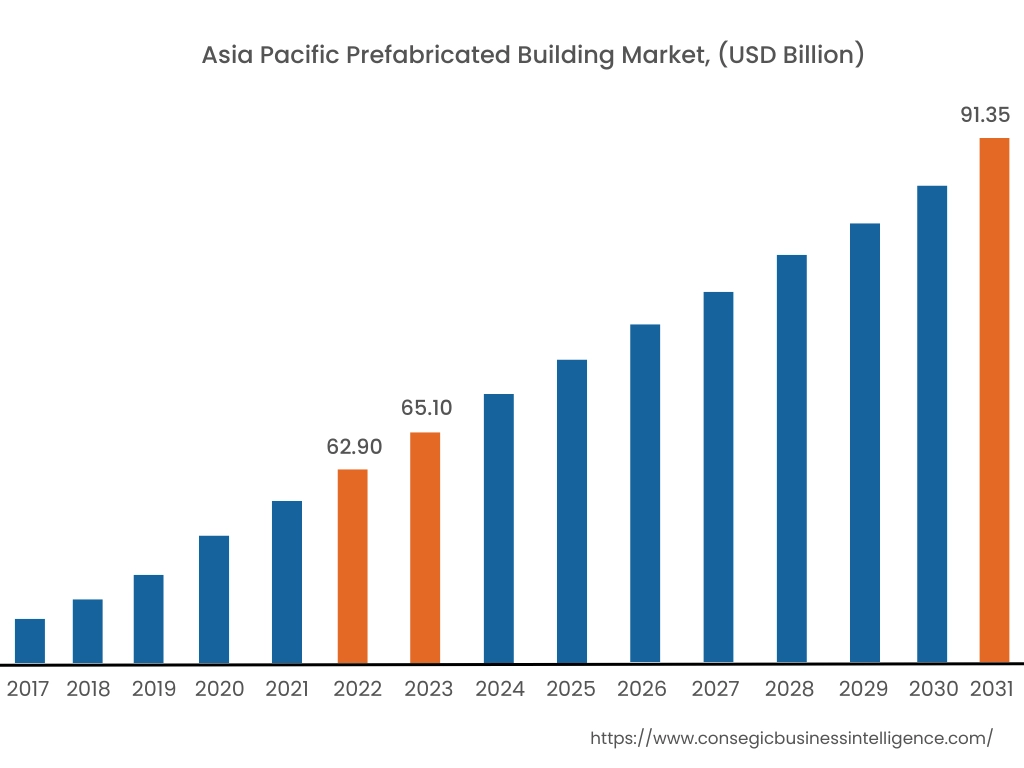
In 2022, Asia Pacific accounted for the highest prefabricated building market share at 34.10%, was valued at USD 62.90 billion in 2022 and USD 65.10 billion in 2023, it is expected to reach USD 91.35 billion in 2031. In Asia Pacific, China accounted for the highest market share of 25.16% during the base year 2022. Based on the prefabricated building market analysis, this is due to the increase in demand for modular houses in this region. Also, factors such as increasing urbanization, a high standard of living, and several favorable initiatives and investments by the government for infrastructure development have been acting as driving factors of the market in the region. Also, increasing awareness of energy efficiency is acting as a catalyst for the expansion of the market in Asia Pacific. Moreover, increasing residential and commercial construction in the region is driving the expansion of the market in this region. For instance, according to a recent report by Invest India, in 2023, the construction sector in India is expected to reach USD 1.4 trillion by 2025. Thus, growing construction activities are leading to an increasing expansion of the market in the region.
Moreover, North America is expected to witness significant development over the forecast period, growing at a CAGR of 4.9% during 2023-2031. This is due to increasing government initiatives for green buildings in this region coupled with the presence of leading market players in the region. Also, increasing awareness of sustainable development across the construction sector is boosting the expansion of the market in North America. Thus, due to the aforesaid factors, the market is witnessing positive expansion in the region.
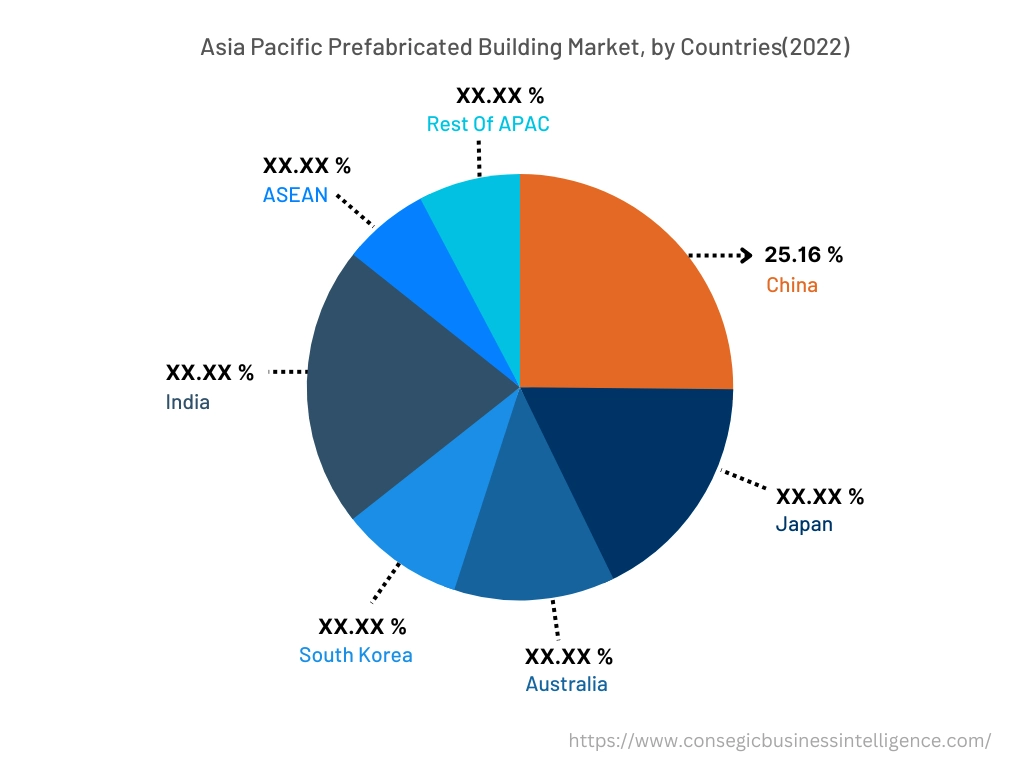
Top Key Players & Market Share Insights:
The global prefabricated building market is highly competitive, with several large players and numerous small and medium-sized enterprises. These companies have strong research and development capabilities and a strong presence in the market through their extensive product portfolios and distribution networks. The prefabricated building industry is characterized by intense competition, with companies focusing on expanding their product offerings and increasing their market share through mergers, acquisitions, and partnerships. The key players in the market include-
- EPACK Prefab
- Arthroto
- Astron Buildings
- Champion Home Builders
- Algeco Scotsman
- CertainTeed
- Mighty Buildings
- Everest Industries Limited
- Satec Envir Engineering (India) Private Limited
- Balarka Fabricon Private Limited
Recent Industry Developments :
- In February 2023, EPACK Prefab, a manufacturer of pre-engineered building solutions, is expanding its manufacturing footprint with an investment of USD 23.88 million to set up a new facility spread over 25 acres in Andhra Pradesh. This facility is expected to be operational by September 2023.
- In September 2023, Mighty Buildings raised around USD 52 million in a funding round co-led by Waed Ventures and Bold Capital with participation by Khosla Ventures leveraging 3D printing to help automate the construction industry. The 3D-printed, prefab homes are considered affordable alternatives to traditional home building.
Key Questions Answered in the Report
What was the market size of the prefabricated building industry in 2022? +
In 2022, the market size of prefabricated building was USD 184.47 billion.
What will be the potential market valuation for the prefabricated building industry by 2031? +
In 2031, the market size of prefabricated building will be expected to reach USD 266.64 billion.
What are the key factors driving the growth of the prefabricated building market? +
Government initiatives in the infrastructure and construction sector is fueling market growth at the global level.
What is the dominating segment in the prefabricated building market by dimension? +
In 2022, the panel segment accounted for the highest market share of 33.27% in the overall prefabricated building market.
Based on current market trends and future predictions, which geographical region is the dominating region in the prefabricated building market? +
Asia Pacific accounted for the highest market share in the overall prefabricated building market.
